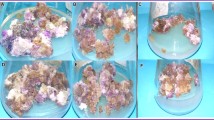Abstract
Feeding stemmadenine to Catharanthus roseuscell suspension culture resulted in the accumulation of catharanthine, tabersonine and condylocarpine. Condylocarpine is not an intermediate in the pathway to catharanthine or tabersonine when it is fed to the cultures. The results support the hypothesis that stemmadenine is an intermediate in the pathway to catharanthine and tabersonine.
Similar content being viewed by others
References
Battersby AR, Hall ES (1969) The intermediacy of geissoschizine in indole alkaloid biosynthesis: rearrangement to the Strychnos skeleton. Chem. Commun. 793-794.
Brown RT, Hill JS, Smith GF, Stapleford HSJ (1969) Rearrangement of catharanthine, stemmadenine and tabersonine in acetic acid. Chem. Commun. 1475–1477.
Brown RT, Hill JS, Smith GF, Stapleford HSJ (1971) On the rearrangement of catharanthine, stemmadenine and tabersonine in acetic acid. Tetrahedron 27: 5217–5228.
Creasey WA (1994) Pharmacology, biochemistry, and clinical applications of the monoterpenoid alkaloids. In: Saxton JE, ed. Monoterpenoid Indole Alkaloids, Vol. 25, Part 4. Chichester, UK: John Wiley & Sons Ltd., pp. 716–733.
Gamborg OL, Miller RA, Ojima K (1968) Nutrient requirements of suspension cultures of soybean root cells. Exp. Cell Res. 50: 155–158.
Heinstein P, Höfle G, Stöckigt J (1979) Involvement of cathenamine in the formation of N-analogues of indole alkaloids. Planta Med. 37: 349–357.
Lounasmaa M, Hanhinen P (1998) Biomimetic formation and interconversion in the heteroyohimbine series. Heterocycles 48: 1483–1492.
Qureshi AA, Scott AI (1968a) Biogenetic-type synthesis of Iboga alkaloids: (±)-catharanthine. Chem. Commun. 947-948.
Qureshi AA, Scott AI (1968b) Interconversion of Corynanthe, Aspidosperma, and Iboga alkaloids. A model for indole alkaloid biosynthesis. Chem. Commun. 945-946.
Sandoval A, Walls F, Shoolery JN, Wilson JM, Budzikiewicz H, Djerassi C (1962) Alkaloid studies, the structure of stemmadenine and condylocarpine. Tetrahedron Lett. 10: 409–414.
Scott AI, Wei CC (1974) Regio-and stereospecific models for the biosynthesis of the indole alkaloids-IIa, biogenetic type synthesis of Aspidosperma and Iboga alkaloids from a corynanthe precursor. Tetrahedron 30: 3003–3011.
Stevens LH (1994) Formation and conversion of strictosidine in the biosynthesis of monoterpenoid indole and quinoline alkaloids. Ph.D. Thesis, Leiden University, The Netherlands.
Van der Heijden R, Hermans-Lokkerbol A, de Kool LPJ, Lamping PJ, Harkes PAA, Verpoorte R (1988) Accumulation of indole alkaloids in a suspension culture of Tabernaemontana divaricata. Planta Med. 54: 393–397.
Verpoorte R, van der Heijden R, Moreno PRH (1997) Biosynthesis of terpenoid indole alkaloids in Catharanthus roseus cells. In: Cordell GA, ed. The Alkaloids, vol. 49. San Diego: Academic Press, pp. 221–299.
Author information
Authors and Affiliations
Rights and permissions
About this article
Cite this article
El-Sayed, M., Choi, Y.H., Frédérich, M. et al. Alkaloid accumulation in Catharanthus roseus cell suspension cultures fed with stemmadenine. Biotechnology Letters 26, 793–798 (2004). https://doi.org/10.1023/B:BILE.0000025879.53632.f2
Issue Date:
DOI: https://doi.org/10.1023/B:BILE.0000025879.53632.f2




